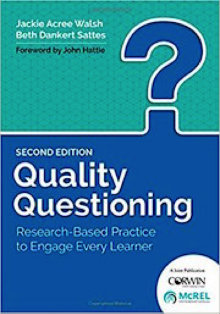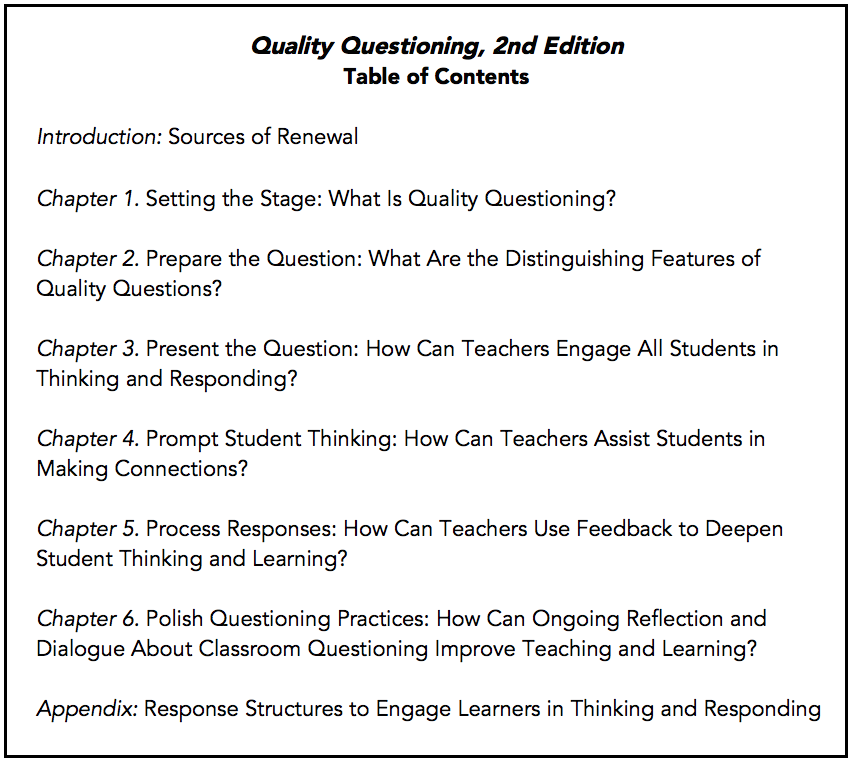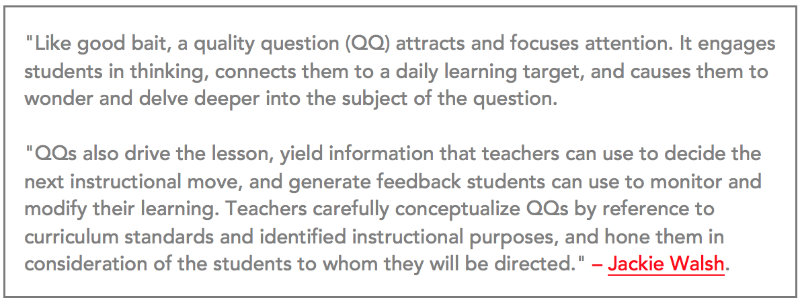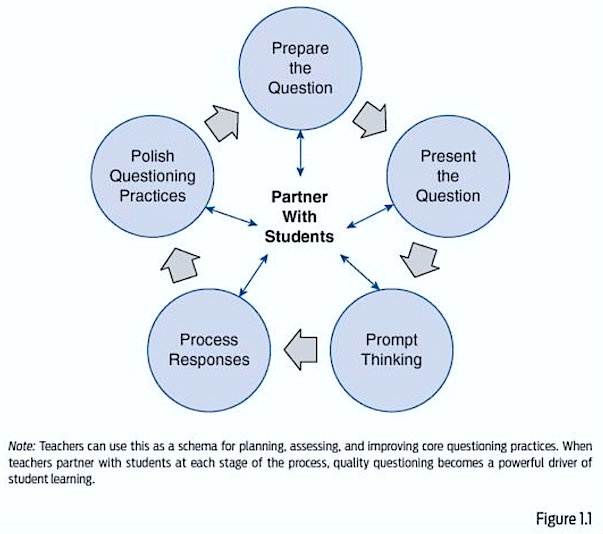Quality Questioning Transforms Classrooms
Quality Questioning Can Help Us Transform Our Classrooms
By Jackie Acree Walsh and Beth Dankert Sattes
(Corwin, 2017 – Learn more)

I have a personal connection to the book I’m reviewing – Quality Questioning: Research-Based Practice to Engage Every Learner (2nd Ed.) by Jackie Acree Walsh and Beth Dankert Sattes – thanks to my professional learning experiences in the Alabama Instructional Partners Network.

Jackie is a master at (p. 95):
► Presenting the question with interest.
► During the posing of the question, stopping and thinking, opening with a statement to set the context for the question, and then pausing, allowing students (participants) to get on the same page with her.
► Asking and stopping – pausing after the question (Think Time 1), and giving encouraging and expectant looks to students (participants), walking around the room, and modeling thoughtfulness.
My observations here are drawn from my many opportunities to experience the research-based advice found in Quality Questioning first-hand.
Powerful response structures
The discussion of “Alternate Response Structures to Help Scaffold and Promote Engagement” in Chapter 3, as well as of the “Response Structures to Engage Learners in Thinking and Responding” in the Appendix, provides a glimpse into the learning that participants in the Instructional Partners Network (IPN) and ABPC’s Powerful Conversations Network (PCN) engage in on a regular basis.
These response structures provide accountability for engagement and participation for all (at times over 100 adult participants). Experiencing these structures in my own professional development has helped me be a better leader of adult learning. I have seen increased engagement in the professional learning days I lead in my building as a result of implementing these structures into my lesson designs.
Our intentions and expectations
My recent opportunity to read Quality Questioning has reaffirmed many of the things I have been practicing with students (who are the primary focus of the book). I was reminded that when teachers tell students, “Keep thinking and I’ll come back to you,” we actually have to come back to them. Students quickly learn our expectations, and if our actions prove to them that they are not held accountable, disengagement will prevail in our classrooms.
We also have to be intentional about not ignoring errors, but rather using them as an opportunity for learning. Having a discussion about what I sometimes refer to as “the best wrong answer” in multiple choice type questions provides a rich discussion about how students are thinking and clears up many misconceptions in the classroom. When we only discuss why the right answer is the right answer we “feed a man for a day.” Helping students justify why they thought the “best wrong answer” could have been the right answer is equivalent to “teaching a man to fish.” Good well-structured questioning like this – leading students through a process of justifying their answers – helps them realize the error themselves and changes their own thinking.
Jackie’s book, however, helps us see that we have to move past the need for right answers in our classrooms. We have to evaluate the questions we are posing to students, and if our questions only have one right answer, we should consider whether our questions (and possibly our instruction) are really rigorous. The “Examples of Questions at Varying Cognitive Levels” (p. 56-57) and “DOK-Examples Related to Four Different Content Areas” (p. 62-63) are great self-assessment tools for teachers to use to evaluate the rigor of their own questions.
Are all questions created equally? Not when considering your purpose and audience. Jackie also helps us see that each question type mentioned in the book has a specific purpose (chart, p. 40-42). We have to be intentional about which type of questions we use and when we use it – based on the question’s purpose and our students’ academic, social, and emotional needs. We have to consider the backgrounds, cultures, and experiences of our students to be able to construct questions that will help our students connect prior knowledge to new knowledge in a way that is engaging to each unique group of students.
What should correct responses sound like? This is another question teachers should think through when planning quality questions so that teachers will be listening for a response that meets the cognitive level of the question asked. “A Template to Plan for Effective Scaffolding” is included (p.128) to help teachers think through their question, possible responses, and follow-up questions to deepen students’ responses.
My nuggets of knowledge
The following is a list of important “nuggets of knowledge” that I want to remember from Quality Questioning:
► Most students don’t understand that when they don’t respond because they are not sure of the answer, they deprive the teacher of information he or she could use to help students learn. (p. 17)
► Teachers who believe questions are tools for actively engaging students in learning dedicate time and effort to formulating a limited number of focus-questions as part of their lesson planning. (p. 26)
► Checks for understanding are questions that gauge student progress toward identified learning goals, and typically engage students in thinking above the simple recall level. Using questions that check for understanding at critical junctures…helps a teacher determine whether to move forward or reteach. (p. 43)
► “No hand-raising except to ask a question, not to answer.” (p. 83)
► To use a particular structure (response structure) successfully, teach it to the students in advance, and let them practice so that they are familiar with the structure before they are asked to use it. (p. 104)
► “No Opt-Out” Policy. The choice between sticking with a student and requiring a response, or giving students a free pass, reflects our beliefs: Do we think all students, with appropriate assistance, can respond correctly? (p. 109-110)
► Life lessons students learn from a classroom that values questioning. (p. 111)
► Teacher prompts that help students understand the question. (p. 125)
► Question stems for students to use to build upon one another’s ideas. (p. 135)
► Seven qualities associated with effective feedback: interactive, reciprocal, informative, understandable, timely, actionable, and capacity building. (p. 147-148)
► Four criteria for praise: contingency, specificity, credibility, and sincerity. (p. 162)
► Feedback of all types typically serves to close or terminate student’s answering. During a discussion where there is no single “right” answer, simple feedback can interfere with –and even shut down – student thinking. All types of feedback should be used sparingly and carefully. (p. 167)
Sharing the learning
Quality Questioning: Research-Based Practice to Engage Every Learner is a book every school should embrace for professional learning. Although the focus is on creating and effectively using quality questions, there are great reminders about classroom culture, teacher expectations, teacher modeling, success criteria, checks for understanding, response structures, and feedback. (There are also free videos showing the strategies in action.)
Every classroom teacher, novice or veteran, needs to learn or be reminded of these practices and how they can transform their classrooms. Each chapter provides Focus Questions to frame the reader’s thinking before reading the chapter and then reflection opportunities throughout the chapter.
The book can be used as a self-paced professional read or would be very conducive to a shared professional reading in a Professional Learning Community (PLC). Chapter 6, “Polish Questioning Practices,” provides a model for professional learning that coaches, school leaders, and district leaders can use to guide their teachers through collaborative planning, observing, and refining practices in ways that accelerate student academic growth.
Read two MiddleWeb articles by Jackie Walsh
based on
Quality Questioning: Research-Based Practice to Engage Every Learner
Energize Your Classroom with Quality Questions
Students Learn Best from Inquiry, Not Interrogation
Debby Smith is the Instructional Partner at Munford Elementary School in Talladega County, Alabama. She began teaching in 1998 and has taught second grade, fifth grade and sixth grade. Before becoming Munford’s IP in 2011, she was the ARI Reading Coach for two years. She holds bachelor, master and educational specialist degrees from Jacksonville State University and is a member of the Alabama Instructional Partners Network.
Debby Smith’s review appeared earlier at the Alabama Best Practices Center’s website.






































Wonderful book. I am doing research on reflective questioning strategies to teachine EFL.
You can find several articles by Jackie Walsh here: https://www.middleweb.com/page/2/?s=jackie+walsh. She has written several books about questioning and has shared her ideas with MiddleWeb.